January, 1959
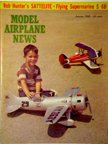
Model Airplane News Cover for January, 1959
Click to Enlarge
Five year old Eric Haack poses with with his Dad's [Turner-Laird Meteor] "Pesco Special" and Great Lakes Biplane Trainer. Mr. Haack had flown the GLT over 200 times and says that it flies inverted does figure eights. The whole family is involved including older brothers Rudy and Lowell and father Robert H. Haack who made the picture. Mr. Haack is supervisor of photography at the Southwest Research Institute, San Antonio, Texas. Mr. Haack has a priceless stable of flying scale models.
Here is a brief discussion of both models shown on the cover.
Turner-Laird Meteor "Pesco Special" Racer
Roscoe Turner, a colonel in the Nevada National Guard, was a famous name in race history since 1924. He was known as "Col. Turner" and appeared in robin's egg blue uniform, whipcord breeches, military cap, and gold wings with RT in bold letters. He also had traveled with a pet lion named Gilmore who got his name from Gilmore Red Lion Oil ("Roar with Gilmore"), one of his many sponsors. He won the 1932 Thompson Trophy at the National Air Races with the Weddell-Williams Racer.
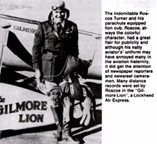
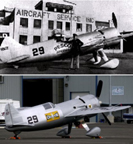
Laird-Turner Meteor ("PESCO Special")
Click to Enlarge
In 1936 Turner contracted with Lawrence W. Brown Aircraft Company to build a racing aircraft of his own design. Detailed engineering work was done by Howard Barlow of the University of Minnesota and the ship was built at the Brown factory in California and completed in mid-year 1936. It was a full cantilever mid-wing monoplane, fixed gear and powered by a Twin Wasp 1000 hp engine. The wing span racer was approximately 25 ft. and quite narrow in chord. The fuselage was constructed of chrome-moly tubing with spruce and fabric fairing. The stabilizers were constructed of wood and the elevators and rudder were steel tubing. All were fabric covered. The paint job was a silver gray, license number R263Y and race number 29. It carried 215 gallons of fuel and had an oil capacity of 15 gallons.
In 1937, the speedster was sponsored by Ring Free Oil and arrived at the Nationals wearing the name "Ring Free Meteor", a star, and race number 29 on its flanks. The name Laird in a diamond appeared on the vertical stabilizer. Due to a variety of mishaps, Turner did not win the Thompson in 1937.
Turner came back to the 1938 National Air Races with his silver Meteor and a determination to win the Thompson Trophy. During the early part of the year he had experienced problems in cooling and lubrication but these bugs had been worked out. The racer's new sponsor was the Pump Engineering Service Corporation of Cleveland. The name "Ring Free" had been removed and "Pesco Special" replaced it. In an eventful race, Turner won the Thompson with a speed of 283.416 mph, turning one lap at 293 mph. With this win he became the only two time winner of the Thompson Trophy Race.
Turner came back back in 1939. No changes had been made in the ship, except Champion Spark Plugs now sponsored and the plane was named "Miss Champion". He went on to win with a speed of 282.5 mph and became the first and only three time winner of the Thompson Trophy Race. After the race Colonel Turner stated that he and the "Miss Champion" were retiring from the race game. Today the racer can be seen hanging in the Roscoe Turner hangar at Indianapolis.
Here is a video of large scale model the Laird-Turner Meteor ("PESCO Special"):
Click Here for more information about the Laird-Turner Meteor ("PESCO Special").
This was a popular airplane and Cleveland rushed to get it out in 1938. You will note that the plans say "PESCO Special" the plane's name in 1938. However, the kit is apparently from 1939 or later because it also includes a "Champion Spark Plugs" label -- just in case the modeler wanted to be courant. We also note that the kit has the blueprints for a pylon-shaped display stand for the model. Like most Cleveland kits, however, it was made to fly -- from the box it looks like you could put a very large ("D" Class) gas engine in the model.
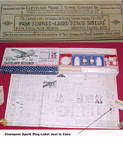
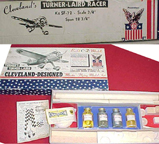
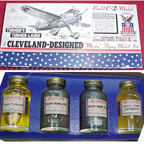
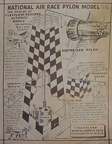
Cleveland Model of the Laird-Turner Meteor ("PESCO Special")
Click to Enlarge
You can buy the plans and patterns that will enable you to make this model right now. Click Here to go to the exact location on the Cleveland Website to get them.
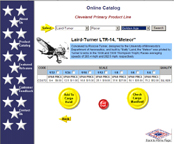
Laird-Turner Meteor ("PESCO Special") at the Cleveland Site
Click to Enlarge
Great Lakes 2T1-A "Sport Trainer" Racing Trainer
In 1929, the Great Lakes Aircraft Company (GLAC) was formed in Cleveland, Ohio They built civilian biplanes, float planes, as well as biplane torpedo bombers but is best known for the enduring 2T biplane; also known as the Great Lakes Sport Trainer. It was designed and sold as a two-place, open cockpit biplane.
The original models had a wing span of 26 feet 8 inches and length of 20 feet 4 inches and the range was 375 miles. The sale price started out at $4,990 but as the depression came it was lowered to $3,985. The first four Sport Trainers built were of a rare straight-wing design, one of which was modified into a special racer. Because of problems recovering from flat spins, the top wing was swept back and that is what most people recognize first when looking at a Sport Trainer.
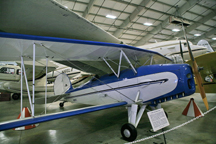

Great Lakes 2T-1A Sportster
Patent for tubing bending device, No. 1,886,082
Click to Enlarge
For about 30 years, until the late 1960s, the Great Lakes Sport Trainer was the top American-made acrobatics plane. During the 1960s Harvey Swack of Cleveland, Ohio, obtained the rights to the Sport Trainer design and all the factory drawings and patents for it (such as the tubing bending device shown above) and then sold plans to homebuilders. There have been a great number homebuilt Great Lakes Sport Trainers built over the years, which kept interest in this old biplane alive. In 1973 Doug Champlin brought the Great Lakes back into production. With the exception of using modern materials, the general design was not changed. Here is the Cleveland Kit for this plane:
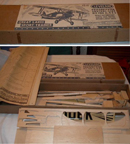
Cleveland Model of the Great Lakes 2T-1A Sportster
Click to Enlarge
You can buy the plans and patterns that will enable you to make this model right now. Click Here to go to the exact location on the Cleveland Website to get them.
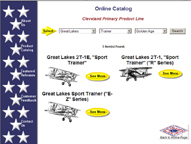
Great Lakes 2T1-A "Sport Trainer" at the Cleveland Site




Click to Enlarge
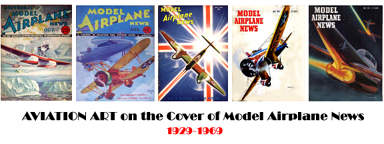
Click to go back and select another cover.
Counter for the Entire Site (not just this page..)
Home | About Lindy | Last Week's Reviews | Upcoming Events | 1940s Collecibles
The Guide - Establishments - Travel - Accessories
Music | Links | Photo Gallery | Extras | Contact